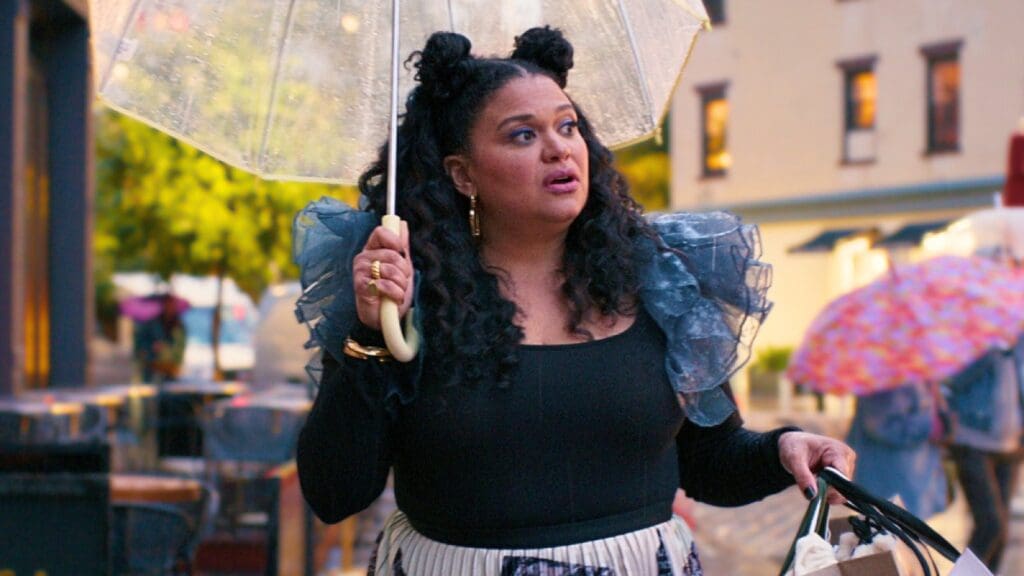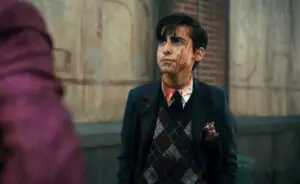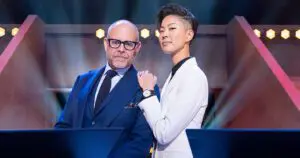Ricky Valero of Ready Steady Cut had the honor of interviewing the extremely talented TV editor John Rafanelli about the new Netflix series Survival of the Thickest.
Survival of the Thickest is a comedy-drama series on Netflix created by Michelle Buteau and Danielle Witzel. The eight-episode series follows Mavis (Buteau), a recently single woman attempting to rebuild her life after getting cheated on by her boyfriend. We had the pleasure of catching up with the co-editor of the series, John Rafanelli, to talk about his time on the show.
John Rafanelli started editing in 2010 as an assistant editor on the TV movie Funny Business – An Inside Look at the Art of Cartooning. Since then, Rafanelli has had his hand editing shows like Netflix’s Emily in Paris and Showtime’s Flatbush Misdemeanor. We sat down to talk about how he got the job working on Survival of the Thickest, working with Michelle Buteau, and the editing process.
An Interview with John Rafanelli, Co-Editor of Survival of the Thickest
Ready Steady Cut: What made you want to get into film editing?
John Rafanelli: Early on, in High School and College, I enjoyed filming random videos and messing around in different editing programs. This was before TikTok and YouTube viral videos. So it was for my own entertainment. After graduating from NYIT, I landed a job at a post-production facility owned and operated by Rob Burgos, NYIT alumni.
I was answering phones and greeting clients. In my downtime, I was able to sit in on edits. Edit rooms that were rented out to various productions. It was there that I truly fell in love with the editing process. Being a fly on the wall watching various television shows finalize their story through editing. So I took on the journey and path to become an editor myself. Rob was great and gifted me with the knowledge and awareness to follow my dreams. He suggested I freelance as an assistant and learn all I can.
So that’s what I did. I assisted on many projects, always eager to learn and craft my own style. Documentaries, reality, and scripted, taking each experience as a learning opportunity. Each project taught me something new and made me more hungry to edit. I’ve been blessed to learn and sit under some of the best in the industry till I finally was able to create my own story and style.
Ready Steady Cut: How did Survival of the Thickest come to fruition for you?
Rafanelli: My previous project before Survival of the Thickest was Flatbush Misdemeanors, where I worked closely with Producer Willy Friedman, Associate Producer Judson Schwartz, and Post Supervisor Lauren Bernstein. After we wrapped, all three of them kindly recommended me for Survival. That was when I interviewed with Michelle Buteau and Danielle Sanchez-Witzel. The two of them made the interview fun, and I felt more like I was talking with friends instead of the typical interview uncomfortableness. Lucky for me, they both decided to hire me as one of the editors.
Ready Steady Cut: What’s the editing process like?
Rafanelli: I love the editing process. It’s the last element, the final puzzle piece, the last line of defense before a show is viewed by an audience. The first time the creators, writers, and directors see their vision come to life.
For me, I start by watching down every take. Doing nothing except watching it down. Watching before ‘action’ is called and after ‘cut’ is said. Then I watch each take down a second time, with an editor’s mindset (what works, what’s funny, what can we cut, what can we keep… etc.… taking notes). This is when I start to do a rough cut of each scene. After each scene is roughed out, I start to assemble the episode in scene order. I watch it all down again. I’m constantly watching things down multiple times.
Next, I really dive in and construct and work on every scene, every beat, every performance. I try to craft the best of all these elements, laying in temp music and sound effects. Preparing to present my best first draft of the episode to the director. I always love trying every avenue and possibility, so often, I may try something outside the box to present different perspectives.
Then the collaboration process happens. In my opinion, it is the most fun part. I get to start working with the directors, the showrunners, and the networks. And together, we try every possible outcome of every scene, emotion, and storyline to make the best episode we can. I honestly love this. The different options, opinions, and outcomes of every scene, every beat, every moment. Together we all work to make the best possible show we can.
Ready Steady Cut: Michelle Buteau wears many hats, from executive producer to writer to star in the project. What was it like to work with her on every level of this project?
Rafanelli: Fantastic! I know that’s a cliche answer, but that’s truly what it was. She cares so much about every episode, story, scene, joke, and character. On top of that, she genuinely cares about us, the employee. I don’t know where she gets the energy from, being on set all day and still responding to edit notes. It’s simply something to aspire to.
I remember one time in the edit, we were working on a scene, and she was looking for a particular improv line from Jade (her roommate). And mind you, this was a month or two after production wrapped, and Michelle said something along the lines of “I think it was the second to last, or last take of Jade’s single coverage, probably towards the end of the take.” Sure enough, we went to those two takes, and it was right there. A random one-off improv line from a character that wasn’t her. But it was important for Michelle that all characters and actors/actresses in the show get their own true moments.
That was something special for me, it was there and then that I understood she truly cared about all of it, the big picture and the little people. Also, I’m happy to say that improv made the final cut! That is just one of many examples of how fantastic it is to work with Michelle. At the end of the day, Michelle and Danielle took so much time to craft the story and progression of every character and every voice, and I loved every moment of it.
Ready Steady Cut: One of the things I noticed was the use of the color palette to express the emotions of what is going on with Mavis. How do you work with that on the editing room floor?
Rafanelli: There’s always a lot going on with Mavis, good and bad, which I love. She’s a wonderful and unique character. There were conversations with me about certain color schemes and aspects when I was working with the directors. And we would spend time making sure certain colors were showing in certain scenes and frames.
But I can’t take credit for the beautiful color schemes that are shown. It was all set up and pre-planned by many talented people from Michelle, Danielle, the Directors, the Set Decorators, the Art Department, The Makeup Departments, the Production Department, and the Wardrobe, I’m sure I’m forgetting multiple assets to the beautiful color palette, but it comes to me already crafted, and I just need to make sure it’s in the frame.
Ready Steady Cut: New York City is an absolutely stunning location that is basically its own character. How do you ensure the city’s authenticity comes off on the show itself?
Rafanelli: It’s always fun working in the New York City environment because, as you said, it is a stunning location and a character of its own.
Craig Cobb (the other editor) and I would spend a lot of time trying to figure out the exterior shots. Of every location we were at, from a character’s home to restaurants, to bodegas, to you name it. We tried to be mindful of the location within NYC, from the time of day to the amount of people that would be on the streets. But again, a big aspect of NYC falls into our wonderful music department, Stephanie Diaz-Matos and Sarah Bromberg, endlessly trying to craft the NYC music scene, from small background music to big explosive music moments. They helped secure that true authentic NYC feeling.
Also, Craig and I would always provide temp NYC sounds to locations and situations, but it was really brought to life by our wonderful mix team led by Evan Benjamin. They really helped solidify the subtle NYC street noise and grit, with a honk, angry pedestrian, or crowd excitement.
Ready Steady Cut: Have you since watched Survival of the Thickest? If yes, what did you think of it?
Rafanelli: I did get a chance to watch it all down since working on it. It was a great opportunity to watch as an audience member instead of someone working on the show. Sometimes it’s hard to differentiate between the two. But after some time has passed, you can sit back and watch.
I loved it, honestly, I felt the joys, the sadness, the jokes, and everything that makes the show uniquely special. I was lucky enough to be at the premiere, and I got to watch an audience laugh or howl at moments we spent so hard to craft, and that felt special to me.
Ready Steady Cut: What is it like watching back that finished project?
Rafanelli: It’s always fun to revisit a show. I often equate editing to writing a college paper. You write, re-read and call it a night, thinking it’s the best thing you ever wrote. Then you go back to that essay two days later and re-read it, and have the realization of “what was I thinking.” So then you re-write the whole thing and change everything.
That is the editorial process, and you do that for many days and many weeks, sometimes months. So it’s always scary watching something 3 months later, anxious and thinking you will realize all of the things you want to change. But you know you can be happy when you watch and think of all the possibilities it could have been, and you are still happy with the product. And for me, that’s how I felt with Survival of the Thickest.
Ready Steady Cut: What might surprise the audience about the editing process?
Rafanelli: I think for me, something that may surprise the audience about the editing process is the number of different forms and shapes an episode evolves into. From the first ‘Editor Cut’ to ‘Picture Lock.’ The attempts to shorten scenes or rearrange them. And the fun that comes along with that in an edit room, like when someone says, “Let’s try this.”
Sometimes it works, and sometimes it doesn’t. But it’s always fun to sample and try. At the end of the day, in editorial, we are the last step, the last line of defense before the audience watches an episode. So for me, it’s always great to try everything!



